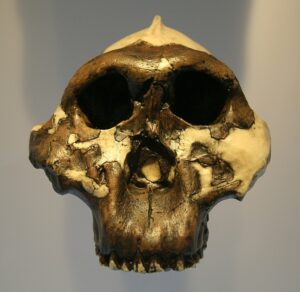Prehistory, as a chronological period, is often defined as the time before the appearance of writing. This definition was formulated at the beginning of the 20th century by Gabriel de Mortillet. He is considered one of the founding fathers of Prehistory and defines it as “the history of man before written documents, figurative documents, even traditions and legends” [6]. Nevertheless, the date of the break between Prehistory and History is subject to discussion.
The term “Prehistory” means “before history”. However, it seems arbitrary to decide that what happens before the appearance of writing does not belong to history. As a reminder, following the discovery of the first Sumerian tablets, it is admitted that writing appeared in Mesopotamia about -3700 years BC. J-C. Nevertheless, at that time, writing was far from being widespread. It takes several centuries, even several millennia, for it to spread throughout the world. Thus, in the West, writing has long been reserved for an elite [4].
Why is this definition problematic?
This definition also raises another issue. Indeed, out of 7,100 languages listed, only 200 are written. So, currently, 97% of the languages are only spoken. Therefore, can we consider the peoples without writing as frozen in the prehistoric stage? Would it be fair to say that they have no history? In response to this problem, some prehistorians suggest using an economic criterion instead.
Jean Guilaine [5], for example, advocates using the beginning of the Neolithic, a period marked by the transition from hunter-gatherer populations to sedentary populations practicing animal husbandry and agriculture, as a marker for the end of prehistory. However, as this transition took place over a long period of time and differently in different regions, there is no clear break between these two subsistence economies. So where do we draw the line between a society based on a predatory economy and a society based on a productive economy? Another problem is that contemporary populations are still nomadic.
It is therefore impossible to define a criterion for the end of prehistory that would work for the whole globe.
When did prehistory begin?
Is it different for the date of the beginning of Prehistory? If prehistory excludes everything that comes before human history, when does human history begin? Overall, three dates are proposed.
The first date places the beginning of Prehistory between 2.8 and 2.5 million years ago (abbreviated thereafter as Ma) with the appearance of the genus Homo in Africa. The second is placed at 3.3 Ma with the manufacture of the first known tools to date. They were discovered in Lomekwi in Africa and are the work of the first Hominins of which the genera Australopithecus, Kenyanthropus and Paranthropus are part. The last date, retained by the majority of prehistorians, is situated between 7 and 5 Ma. It is thus this period that we will retain as the beginning of Prehistory. It corresponds to the last common ancestor between chimpanzees and human beings and to the appearance of the human lineage.
The dinosaurs having disappeared about 65 Ma ago are therefore not part of Prehistory.
The scientific discipline
As for prehistory, it is the scientific discipline that studies prehistory.
The prehistorian, unlike the historian, has no written material to refer to. It can only be based on material elements collected during excavations and prospecting. In the absence of writings and testimonies, the interpretation of the materials leaves room for a large number of hypotheses and possible interpretations. Scientific constructions are therefore the result of years of research and complex studies that require the contribution of many disciplines such as paleoanthropology, archaeozoology, palynology or carpology without which prehistory could not exist.
The study of prehistory requires, as for any scientific discipline, the ability to question commonly accepted theories but also and above all to admit that perhaps certain questions will never be answered.
Feel free to ask us questions and give us feedback on the blog. You can also contact us by e-mail. You can also follow us onInsta, Facebook, TikTok, Linkedin, Youtube and Twitter!
See you soon,
The Prehistory Travel team.
Article Bibliography:
- [1] Balzeau Antoine, De Beaune Sophie A., La Préhistoire, collection Chroniques de l’Homme, CNRS editions, 2009.
- [2] Bar-Yosef, Ofer. “The Archaeological Framework of the Upper Paleolithic Revolution,” Diogenes, vol. 214, no. 2, 2006, pp. 3-23.
- [3] De Beaune Sophie A., Qu’est-ce que la Préhistoire ?, éditions Gallimard, collection Folio Histoire, 2016.
- [4] Groenen Marc, Introduction to Prehistory, ELLIPSES editions, 2009.
- [5] Guilaine Jean, Archaeology, human science. Interviews with Anne LehoërffParis, co-publishing Actes Sud-Errance, 2011.
- [6] Mortillet G., Mortillet A. de, Prehistory. Origin and antiquity of man. Paris, Librairie Schleicher Frère, 1900
- [7] RadioFrance broadcast of March 1, 2016, “What is Prehistory?”, https://www.radiofrance.fr/franceinter/podcasts/la-tete-au-carre/qu-est-ce-que-la-prehistoire-9852695



